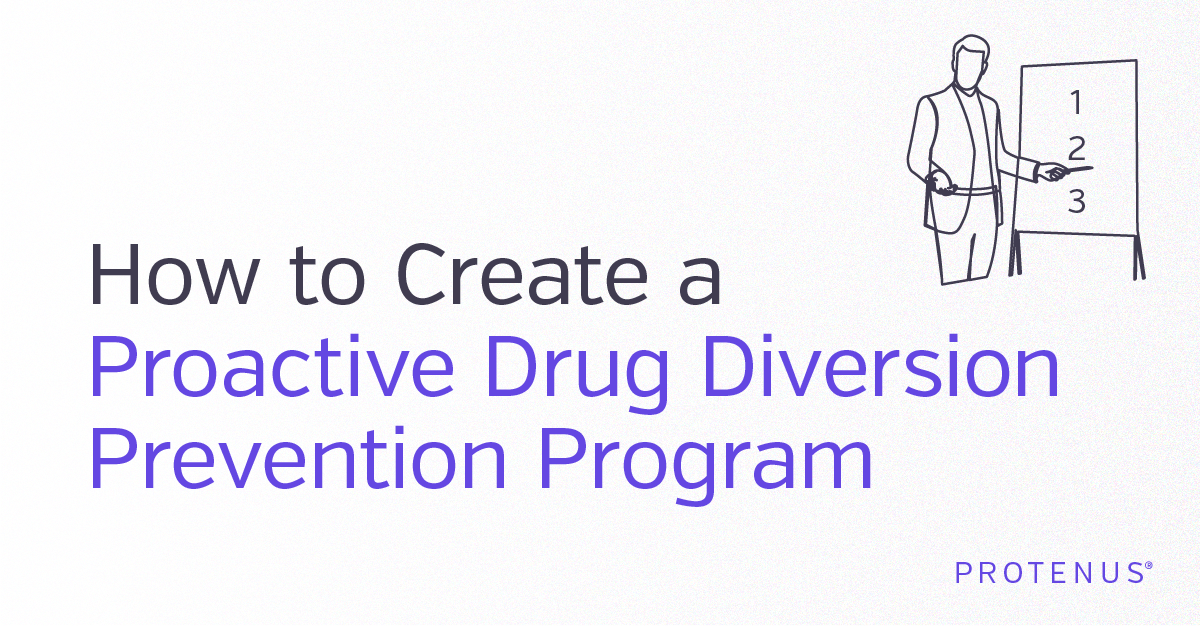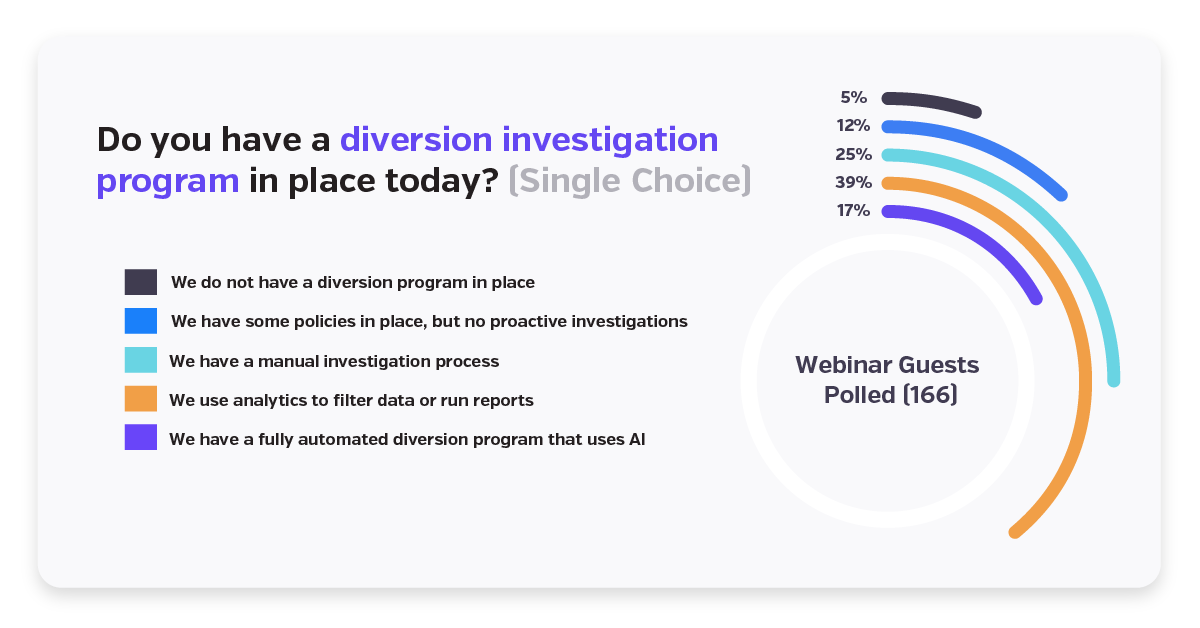Share this

How to Create a Proactive Drug Diversion Prevention Program
by Amanda Rogers, Marketing Content Writer, Protenus on November 2, 2022
Healthcare compliance professionals combating drug diversion at their organizations are under more pressure than ever due to factors like a raging opioid epidemic, staffing shortages and burnout, and travel nurses unaware of the healthcare organization’s policies and procedures. In a time where hospital leaders are being asked to do more with fewer resources, leveraging technology is the way forward.
Is your healthcare organization currently able to effectively monitor up to 100% of medication transactions and quickly resolve investigations? If you're using a manual, report-based approach, the answer is no. Legacy solutions are reactive, with no ability to predict and prevent diversion. To best protect your organization, workforce, community-at-large, and most importantly, your patients, it's crucial to incorporate technology like artificial intelligence into your proactive drug diversion prevention efforts.
Watch now! "Do More With Less: How to Create a Proactive Drug Diversion Prevention Program" webinar for industry expert insight on how technology helps healthcare organizations mitigate risk.
If you're considering or ready to create a world-class controlled substance diversion prevention program, you don't have to start from scratch. We've tapped industry experts on AI and drug diversion prevention to illustrate three ways technology saves time and resources needed to quickly detect and proactively predict and prevent clinical drug diversion, and share five best practices for creating or elevating your own proactive program.
Is Your Organization With the Program?
According to the American Society of Health System Pharmacists (ASHP), every healthcare organization is responsible for creating a controlled substance diversion prevention program (CSDPP) that “complies with applicable federal and state laws and regulations but also one that applies technology and diligent surveillance to routinely review process compliance and effectiveness, strengthen controls, and seek to proactively prevent diversion."
However, in a recent survey of 166 healthcare compliance professionals, Protenus found that 42% of respondents were still using a manual approach or did not have any diversion program in place.

This leaves their healthcare organizations open to huge clinical, financial, and reputational risk that can be nearly impossible to recover from.
3 Ways AI Saves You So Much Time
Artificial intelligence (AI) is vital to drug diversion monitoring because it can review every medication transaction and surface potential suspicious behavior faster and more accurately than manual methods. Time is of the essence when detecting diversion to reduce risk to patient and workforce safety as well as organizational reputation and finances.
A recent study in the American Journal of Health-System Pharmacy showed that advanced analytics and machine learning detected diversion 160 days earlier than methods not using that technology. Firsthand, Protenus has seen our customers’ diversion detection time drop by 80% or more when switching from a legacy solution, and they’re able to detect diversion within 50 days of the incident occurring, on average.
How exactly does leveraging AI slash time and resources needed for a proactive drug diversion prevention program?
“AI is not magical. It takes a number of very simple questions and scales that up to a really high level. Think of all the information you know at the end of a diversion investigation. Now imagine the AI asking those questions against every single medication transaction and prioritizing the answers that matter most. With AI, you’re really starting from the finish line of a diversion investigation and are able to take action quickly from there.", says Nick Culbertson, Protenus CEO & Co-Founder.
Here are three concrete examples of AI's time saving capabilities over a manual legacy approach:
- AI tells you WHO you should look at. “AI looks at so much data from EMR to EHR and more, and instead of just reporting on high dispenses, it gives you many different factors that will bubble up the employees you need to look at." says Terri Vidals, B.S. Pharm, Rxpert Solutions Drug Diversion Mitigation Specialist.
- AI lets you easily compare users to peers to show whether a whole unit is not following policy or if this user is really an outlier. Doing an investigation manually to compare each peer would take more time than you have.
- AI helps you quickly investigate and resolve cases because you have so
much information at your fingertips. Nick Culbertson says, “AI is not only helpful in detecting those questionable cases right away, it’s also helpful in explaining the reactive investigations that come from a compliance hotline, complaints through a nurse manager, or suspected behaviors. You don’t have to then start a full investigation from scratch, you can review the AI’s investigation to check whether the person has a high suspicion score.”
Staffing shortages, especially in the pharmacy tech space, and high
turnover cause a lot of work when constantly training new hires on a manual drug diversion investigation process. Having that AI and automation as part of a diversion prevention program provides a well-documented, well-audited engine that’s key to ensuring a continuity of compliance”. – Nick Culbertson,
Protenus CEO & Co-Founder
"But it's not about just buying the AI and checking a box, you need to have a drug diversion program around that," advises Culbertson.
5 Best Practices to Build a World-Class Diversion Prevention Program
It can be difficult to know where to start when creating a diversion prevention program — the good news is that health systems don't have to go it alone, you can lean on experts and peers who have gone through the process before. We asked Terri Vidals for best practices she's curated from her deep knowledge of controlled substance diversion mitigation and 30 years experience as a Hospital Pharmacist.
- Educate leadership & frontline staff on drug diversion. In another recent survey of 185 healthcare compliance professionals, Protenus found that 23% did not believe diversion is happening in their organizations. Start with education. Everyone from leadership to frontline staff to janitorial staff needs to know drug diversion is real, what it is, how to recognize it, and how to report it.
- Identify a champion. You need someone that has diversion mitigation at the top of mind always. During every meeting, every process change, every discussion, they'll be thinking of whether decisions will create gaps in processes, workflow, chain of custody and security that increase your risk of drug diversion.
- Build your diversion response team. Ensure buy-in by assembling a cross-functional team to handle investigating, reporting, and document maintenance so you're ready when the licensing board calls.
- Review policies and procedures to define a basis for creating
processes. For example, if you don't specify in your policy how long somebody has to waste a medication after removal, they can't be disciplined. Standardizing the investigation process, including interviews, is key. - Decide what your culture’s going to be. Will you automatically terminate employees proven to have diverted drugs, or will you help rehabilitate and reintegrate them? They're more likely to come to you for help with addiction if they know it's a supportive environment.
Interested in learning more about what your health system can achieve by leveraging AI? Click here to watch our joint webinar with Inmar Intelligence: "Doing More With Less: How to Create a Proactive Drug Diversion Prevention Program".
Share this
- December 1, 2024 (3)
- November 1, 2024 (1)
- October 1, 2024 (2)
- September 1, 2024 (1)
- August 1, 2024 (1)
- July 1, 2024 (1)
- June 1, 2024 (1)
- May 1, 2024 (1)
- March 1, 2024 (2)
- February 1, 2024 (3)
- January 1, 2024 (1)
- December 1, 2023 (1)
- November 1, 2023 (3)
- October 1, 2023 (3)
- September 1, 2023 (1)
- August 1, 2023 (1)
- July 1, 2023 (2)
- April 1, 2023 (1)
- March 1, 2023 (1)
- February 1, 2023 (1)
- December 1, 2022 (3)
- November 1, 2022 (3)
- October 1, 2022 (1)
- September 1, 2022 (1)
- August 1, 2022 (2)
- June 1, 2022 (4)
- May 1, 2022 (5)
- April 1, 2022 (1)
- March 1, 2022 (4)
- February 1, 2022 (3)
- November 1, 2021 (2)
- October 1, 2021 (3)
- September 1, 2021 (3)
- August 1, 2021 (3)
- July 1, 2021 (4)
- June 1, 2021 (2)
- May 1, 2021 (2)
- April 1, 2021 (2)
- March 1, 2021 (5)
- February 1, 2021 (1)
- January 1, 2021 (1)
- December 1, 2020 (1)
- November 1, 2020 (2)
- October 1, 2020 (2)
- September 1, 2020 (3)
- August 1, 2020 (2)
- July 1, 2020 (2)
- June 1, 2020 (6)
- May 1, 2020 (3)
- April 1, 2020 (4)
- March 1, 2020 (2)
- February 1, 2020 (4)
- January 1, 2020 (2)
- December 1, 2019 (2)
- November 1, 2019 (1)
- October 1, 2019 (1)
- September 1, 2019 (1)
- August 1, 2019 (1)
- June 1, 2019 (1)
- April 1, 2019 (1)
- February 1, 2019 (1)
- January 1, 2019 (1)
- December 1, 2018 (2)
- November 1, 2018 (2)
- October 1, 2018 (2)
- September 1, 2018 (3)
- August 1, 2018 (1)
- July 1, 2018 (2)
- June 1, 2018 (2)
- May 1, 2018 (1)
- April 1, 2018 (1)
- March 1, 2018 (2)
- February 1, 2018 (6)
- January 1, 2018 (2)
- September 1, 2017 (2)
- August 1, 2017 (2)
- June 1, 2017 (2)
- May 1, 2017 (1)
- April 1, 2017 (1)
- March 1, 2017 (2)
- February 1, 2017 (5)
- January 1, 2017 (2)
- December 1, 2016 (3)
- November 1, 2016 (5)
- October 1, 2016 (4)
- September 1, 2016 (8)
- August 1, 2016 (4)
- July 1, 2016 (4)
Subscribe by email
You May Also Like

Conserving Resources with Compliance Analytics: A 5-Step Implementation Guide

Enabling Greater Healthcare Efficiency with Protenus AI Technology

